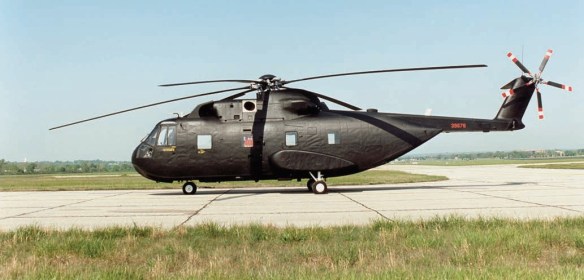
The bulk of the USAF CH-3C helicopters deployed to South-East Asia in 1967 belonged to two units: the 20th and 21st Helicopter Squadrons. The former was nicknamed the `Pony Express’ and the latter the `Dust Devils’. Despite their mundane unit designations and colourful nicknames, these units were in reality USAF Special Operations Force (SOF) units. They were tasked with running covert missions, typically involving the delivery into and recovery of unconventional warfare teams in the countries surrounding South Vietnam.
Besides its CH-3C helicopters, the 20th Helicopter Squadron also began using thirty-one units of the UH-1F Huey, some of which were later reconfigured as UH-1P gunships. Their job was to escort the CH-3C helicopters during their missions. Eventually they took into service the twin-engine UH-1N Huey, some of which were also converted into gunships. Reflecting their multi-coloured camouflage paint schemes, the Hueys were unofficially nicknamed the `Green Hornets’.
In 1969, the Dust Devils took over the CH-3Cs and Hueys of the Pony Express as well as their missions. In 1970, the number of covert missions was greatly reduced as a new American president was trying to bring the war in South-East Asia to a close and reduce the number of American casualties. All the men and the helicopters of the Dust Devils stood down in 1972, with American military involvement in the war coming to an end in the following year.
Included among the sensor arrays mounted on the front fuselage of the MH-53 Pave Low series helicopter pictured would be FLIR and terrain-following radar. Other sensors carried on board would be the Global Positioning System (GPS) and an Inertial Navigation System (INS). The aircraft carried a crew of six: two pilots, two flight engineers and two gunners.
Taking part in a training exercise is an MH-53J Pave Low III. The helicopter had a length of 88ft and a height of 17ft 2in. Empty it weighed 23,570lb and had a maximum take-off weight of 42,000lb. The maximum speed was 196mph with a service ceiling of 16,000ft. Its range on external fuel tanks was 540 miles.
Pave Low
In the 1980s the USAF as an experiment had eight of their remaining Vietnam War-vintage HH-53 series helicopters rebuilt from the ground up and fitted with the latest in avionics. They therefore became the MH-53H Pave Low. The word `Pave’ is an acronym for Precision Avionics Vectoring Equipment and the word `Low’ reflects the fact that the helicopter could now fly nap-of-the earth (NOE) around the clock and in adverse weather conditions.
The advanced capabilities of the MH-53H Pave Low soon caught the attention of the Air Force Special Operations Command (AFSOC). This resulted in the former CSAR helicopter assuming new roles such as long-range infiltration and exfiltration. Positive results with the MH-53H Pave Low led to an upgraded model designated the MH-53J Pave Low III.
One of the most important later additions to the MH-53J Pave Low III was referred to as the Interactive Defensive Avionics System/Multi-Mission Advanced Tactical Terminal, or IDAS/MATT. A description of the device appeared in an online USAF article dated 19 October 1998:
A color, multifunctional, night-vision compatible digital map screen is the most visible hardware in the system. Located on the helicopter’s instrument panel, the display gives an MH-53 crew a clearer picture of the battlefield. Crews have access to near real-time events, including the aircrew’s flight route, man-made hazards such as power lines and even enemy electronic threats that are `over-the-horizon’. Transmissions are beamed from a satellite to the helicopter’s computer and then decoded. The data from the screen provides a perspective of potential threats and their lethal threat radius.
Reflecting the heightened level of capabilities provided by IDAS/MATT, the MH-53J Pave Low III was relabelled as MH-53M Pave Low IV. Despite this enhancement, all the Pave Low helicopters were retired from USAF service in 2008. The 2009 replacement for the MH-53M was the CV-22B Osprey. Like its predecessor, it is equipped with an integrated threat countermeasure system, terrain-following radar, forward-looking infrared sensor and other advanced avionics systems.